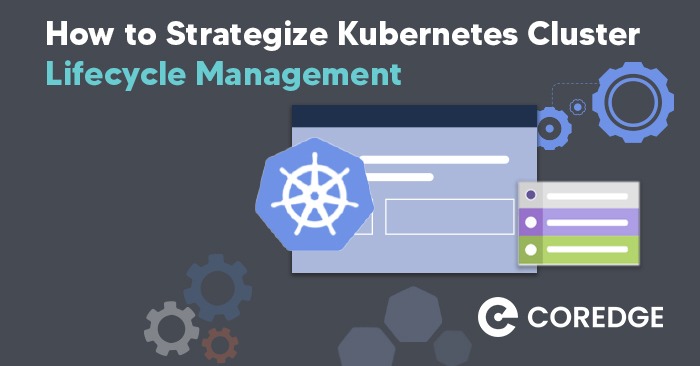How to Strategize Kubernetes Cluster Lifecycle Management
Coredge Marketing
October 18, 2022

Overview
Kubernetes environments are becoming highly distributed with modern cloud-native applications. They can be deployed across multiple data centers on-premise, in the public cloud, and at edge locations.
Organizations that want to use Kubernetes at scale or in production will need to be able to manage many clusters deployed across environments, such as those for development, testing, and production.
The biggest problem with Kubernetes is a lack of or improper security. It might be challenging to manage security across several clusters while still giving users of the clusters the appropriate privilege and access. Since the cluster administrator is in charge of overseeing everything, they will have complete access to all functions. Application owners should only have the minimal amount of access necessary to operate their applications without interfering with other namespaces or causing cluster disturbances. Additionally, SREs (Site Reliability Engineering) will have access to the clusters to address any production-related problems. Therefore, choosing the appropriate security model is essential when operating a cluster, as doing otherwise may result in a possible issue.
Why is Kubernetes cluster management important?
According to a CNCF survey, 55% of the respondents said that they are facing problems because they do not have in-house skills, or are not able to hire the right talent. Due to the rapidly evolving nature of Kubernetes and the vast CNCF landscape, where there are so many open-source projects and people adopting open-source tools, it might be challenging to locate individuals with the abilities to use the numerous plethora of these tools.
The expense of administering these throughout a business can quickly escalate based on the number of clusters since current Kubernetes environments require management at the individual entity or a group of cluster level.
Each cluster needs to be deployed, upgraded, and secured separately. Additionally, manual deployment or distribution outside of the Kubernetes environment control is required if applications need to be distributed between environments. At the individual cluster level, managing day 2 operations like patching and upgrading take time and are prone to error.
Managing a Kubernetes cluster lifecycle revolves around creating, deployment operation, update and upgrade, and deletion phases.
When new clusters are needed, developers want to access them quickly. New clusters must be properly set up for operations teams and SREs to have access to production applications. Cluster health is something that Ops and SREs want to keep an eye on in your environment.
When working in a variety of contexts where Kubernetes clusters are deployed, administrators and SREs frequently confront difficulties that are addressed by Kubernetes cluster management.
Strategies for Kubernetes cluster lifecycle management
There are three core things a platform should have for managing the Kubernetes cluster lifecycle:
1. Zero Trust Security:
The platform should have zero trust security, which means that you will never trust, and always verify. While it should allow users to come, it should also allow lots of customizations in the roles or RBAC access. Controlling access to the API server, the central component of each cluster’s Kubernetes control plane, is essential to implementing zero-trust principles in your Kubernetes setup. Controlling access to API use is essential to protecting your workloads and attaining Kubernetes zero trust because API calls are used to query assets like namespaces, pods, and configuration maps.
2. Centralized Visibility and Management:
Any platform should provide complete visibility of every multi-cloud and multi-cluster on a single piece of glass, along with effective centralized management. Across all of the various clusters or clouds, you ought to be able to see your inventory, how many virtual machines you have, and how many clusters or pods you have. This will help you better plan for any new applications or demands that could appear.
3. Fleet-wide Lifecycle Management
As we all know, Kubernetes environments expand with time with the assistance of numerous cloud providers like Amazon EKS and Azure AKS. Although fundamentally identical, each of these Kubernetes types has a separate set of management tools, which means that when deploying and updating clusters in each environment, the results can be different. The best course of action in this situation is to organize the company around a single type of Kubernetes, one that is capable of carrying out fleet-wide life cycle management. Finding a SaaS service provider that enables customers to deploy, manage, and upgrade all clusters from a single pane of glass, a dashboard that enhances visibility, reliability, and consistency, is the best practice for strategizing Kubernetes cluster lifecycle management.
Why choose Coredge for Kubernetes cluster lifecycle management?
The ideal Kubernetes cluster management tool lets you manage application life cycles across hybrid environments and gives you visibility into your clusters. With built-in security policies, the Coredge Kubernetes Platform manages clusters and apps from a single console. When working across a variety of settings, such as different data centers and private, hybrid, and public clouds, enterprises confront issues that must be addressed. Coredge Kubernetes Platform provides the capabilities to address the challenges organizations face.
- All of your Kubernetes clusters can be deployed, managed, and upgraded from a single console across all your edge nodes.
- With the Coredge CloudCompass controller, Kubernetes clusters can be provisioned easily at the edge. They can be updated and upgraded without any downtime.
- For detailed cluster resource visibility and monitoring across the edge environments, the CloudCompass controller integrates with a variety of logging metric platforms.
- With CloudCompass controller, you can manage target clusters and compass clusters remotely.





